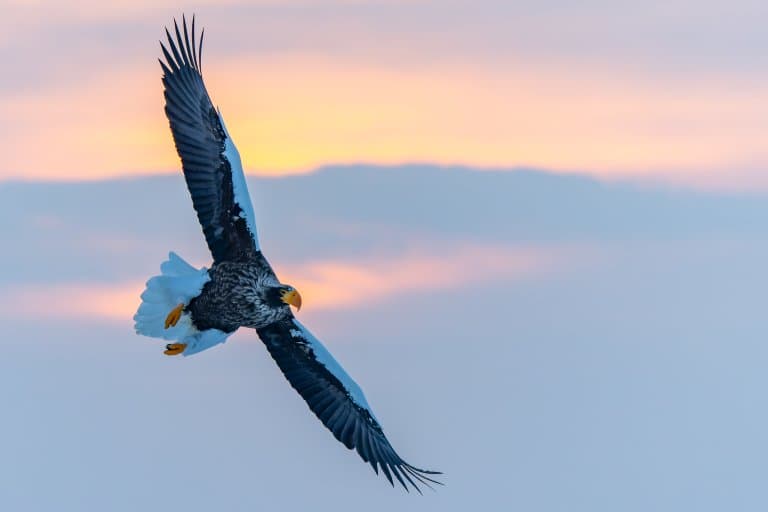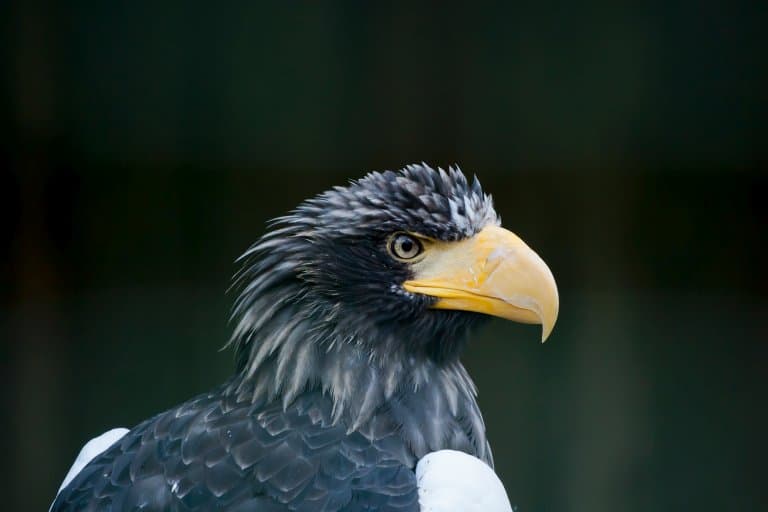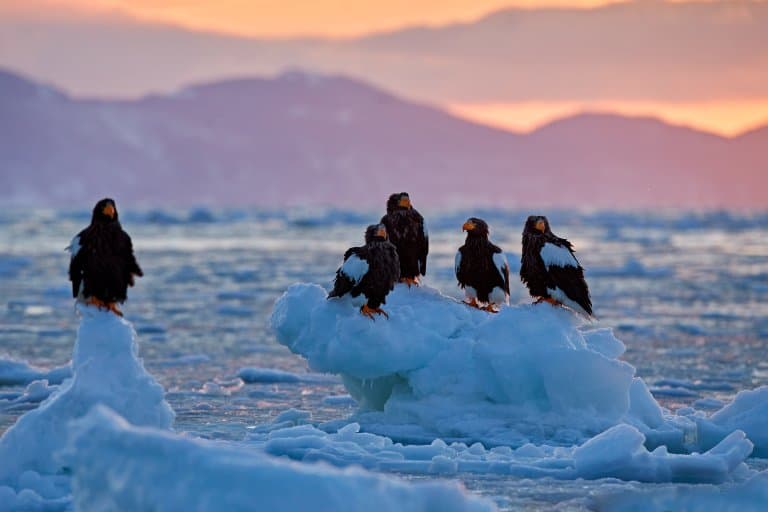Steller’s Sea Eagle Profile
If you’re ever a little disappointed that dinosaurs are extinct and you’ll never get to meet one, it’s worth understanding that they only mostly died out. A whole bunch of small ones survived the extinction event and are still among us as birds.
And while your everyday garden sparrow doesn’t really have the same kick to it, there are some birds around that remind us what the incredible prehistoric predators could have been like to witness.
The Stellar’s sea eagle is one of them, and it comes complete with authentic Dino vocals, too! They are sometimes called the Pacific sea eagle or white-shouldered eagle and are a huge bird of prey that is native to Northeast Asia.

Steller’s Sea Eagle Facts Overview
| Habitat: | Forest, wetlands, rocky areas |
| Location: | Eastern Russia, China, Mongolia |
| Lifespan: | 30 years |
| Size: | 105 cm (3 ft 5 in) long, 2.2m – 2.7 m (7ft 3 in – 8ft 10 in) wingspan |
| Weight: | Up to 10kg (22lb) |
| Colour: | Dark plumage with white shoulders, tail, rump |
| Diet: | Fish, fish carrion. Some birds, squid, crabs. Sometimes mammals |
| Predators: | None |
| Top Speed: | Unknown |
| No. of Species: | 1 |
| Conservation Status: | Vulnerable (IUCN) |
Steller’s sea eagles are enormous raptors from the Easternmost coasts of Eurasia in Russia, Korea, Japan, China, and Taiwan. They’re not well researched, partially on account of them living in some pretty bleak (yet stunningly beautiful) places.
These are fish specialists but will eat meat from almost anywhere, and their striking colouration, coupled with their immense size makes them impressive animals to behold.
Their favored prey are pink salmon and trout, and they have been recorded in groups of up to 700 eagles around the riverbanks when there is an abundant food supply. As well as fish, they will also take water birds such as swans, ducks, herons and cranes and even some mammals when inland.
Sadly, human development threatens their feeding grounds, and the species is now vulnerable.
Interesting Steller’s Sea Eagle Facts
1. Their name is derived from German naturalist ‘Georg Wilhelm Steller’
Georg Wilhelm Steller was a German explorer, who worked in Russia and went on a number of expeditions from Saint Petersburg in the 1700’s.
On his voyages he discovered a number of animals, including six species of birds, one of which was named the ‘Steller’s sea eagle’.
He also discovered the similarly named Steller’s sea cow, Steller sea lion, Steller’s eider and Steller’s jay – amongst others!

2. They are the only sea eagle with a bright yellow beak and feet
The Steller’s sea eagle is the only sea eagle with a distinctive yellow beak, even in juvenile birds. Their bill can measure up to 4.5 inches in length, which is the largest of any living eagle species.
They also have yellow feet, with hooked sharp talons to help fishing.
While their talons are not as long as some eagles, they are extremely powerful and there is a documented cases of a talon piercing through to the other side of a wildlife vets arm.

3. There are two morphs
For a long time, people wondered what this giant black eagle was, hanging around with the Steller’s sea eagles, behaving very similarly, and looking super cool. Whether it was a different subspecies a mutation, or just a very rare morph was all up for debate, along with the question of whether this thing existed at all. Some even said it might just be a growth stage of the Steller’s eagle.
Fairly recently, captive breeding produced a limited edition, matte-black model that was just a very rare morph of the base model. They’re very rare, and where the pale morphs have white foreheads and butts, the brooding dark morphs have no white at all.
4. They can moult into a dark morph
The fact that this dark morph came from pale morph parents shows that this can’t be a case of speciation, but a rare mutation, similar to the melanistic variants of some mammals. In birds, melanism is actually one of the most common polymorphisms present.
In fact, the dark morph discovered in Berlin Zoo started life as an ordinary-looking eagle. It was only when the young eagle moulted into its final adult plumage that it became known it was a dark morph. As of yet, there are no subspecies described. 1 2
5. They’re one of the heaviest eagles
Regardless of what colour they come in, these are heavy birds. On average, they’re the heaviest eagle known, and only beaten by outliers of other species like the Harpy and Philippine eagles.
Steller’s sea eagles reach up to around 10kg, which is a terrifying mass when sitting still, but if you add enormous talons and the momentum gained from swooping, it packs a serious punch!
They also have a huge wingspain of up to 2.5m (8ft 2) which is only behind the Wedge-tailed eagle in our largest eagles in the world by wingspan list. 3
6. Steller’s sea eagles will steal food from others
This is known as ‘kleptoparasitism’, and is common when feeding occurs in groups.
Steller’s sea eagles hunt mostly from a perch up a rocky ledge, or up in a tree above the water. But they can also hunt by circling above the water and diving to catch prety.
While fish will make up over 80% of the diet of eagles nesting near rivers, along coastlines water birds can be more common prey.
When inland, these eagles will hunt mammals, with arctic fox, domestic dogs, sika deer and even seal pups on the menu.

7. They have an acrobatic mating dance
Despite all this weight, they’re surprisingly agile birds, and their copulation rituals are opportunities to show this off.
Such mating dances can occur as high up as 2,000 meters and involve the male circling and stooping in undulating spirals over the female. Rapid stooping like this is a sign of a powerful and adept hunter and should persuade the female that the male has the genes necessary to sire strong offspring.
If the demonstration is successful, the male lets out a victory cry that can be heard from 3km away. Steller’s sea eagle make a deep barking cry, ra-ra-ra-raurau. 4
8. They’re monogamous
Males and females find and secure a breeding site early, where they will stay in one another’s company until it’s time to build a nest.
Building begins in February, and the courtship routine starts around March. The pair will build and look after up to four nests in their territories, which they will return to from year to year, alternating between them, probably as a means of reducing parasite load, in the same way that a farmer would rotate crops.
These nests are appropriately large, reaching up to two meters across, and will host 1-3 eggs per clutch.

9. They’ve been known to skip breeding
This species is sensitive to environmental changes, and if the mood isn’t right, they’re known to skip a breeding season. This aversion to risk is a good strategy in times of plenty; breeding is expensive, and it can be better to save the health and resources of both parents until conditions improve in the following year.
But when the problem is the encroachment of human development, conditions for the bird are unlikely to improve, and this clever strategy can work against the species. Understanding this, however, is the key to their protection. 5
10. Sadly, they are under threat
You’d think a bird that spends much of its time on the frozen coast of the Far East would be isolated from human development but there is almost nowhere on Earth that is safe from our expansion, on land or in the water.
Steller’s sea eagles are suffering from habitat alteration as hydroelectric dams and offshore fossil fuel developments convert their hunting grounds into industries.
From inland, waterways are being polluted with heavy metals and logging is reducing nesting grounds. Overfishing is reducing their food supply, leading to increased rates of scavenging, which brings them into direct competition with hunters. If they’re not shot as pests, they can develop poisoning from eating a deer carcass riddled with lead shot.
Climate change, as always, is compounding these issues, and the species is currently Vulnerable and in decline. The ability to skip breeding seasons under these conditions reduces the speed at which the populations can recover and accelerates their decline. 6

Steller’s Sea Eagle Fact-File Summary
Scientific Classification
| Kingdom: | Animalia |
| Phylum: | Chordata |
| Class: | Aves |
| Order: | Accipiriformes |
| Family: | Accipitridae |
| Genus: | Haliaeetus |
| Species: | Haliaeetus Pelagicus |
Fact Sources & References
- Ella Davies (2010), “Dark Steller’s sea eagle solves 100 year debate”, Earth News.
- Martin Kaiser (2010), “A living specimen of the dark form of Steller’s Sea Eagle, Haliaeetus pelagicus (‘‘niger’’) in captivity”, Sci Hub.
- Falconry & Avian Raptors (2020), “Steller’s Sea Eagle (Haliaeetus pelagicus) – Is the heaviest eagle on the planet.”, YouTube.
- Eugene Potapov (2015), “Steller’s Sea Eagle Haliaeetus pelagicus: display and copulation in early spring”, Research Gate.
- Michael S. Romanov (2020), “Low breeding performance of the Steller’s sea eagle (Haliaeetus pelagicus) causes the populations to decline”, Science Direct.
- “Steller’s Sea-eagle”, IUCN Red List.
